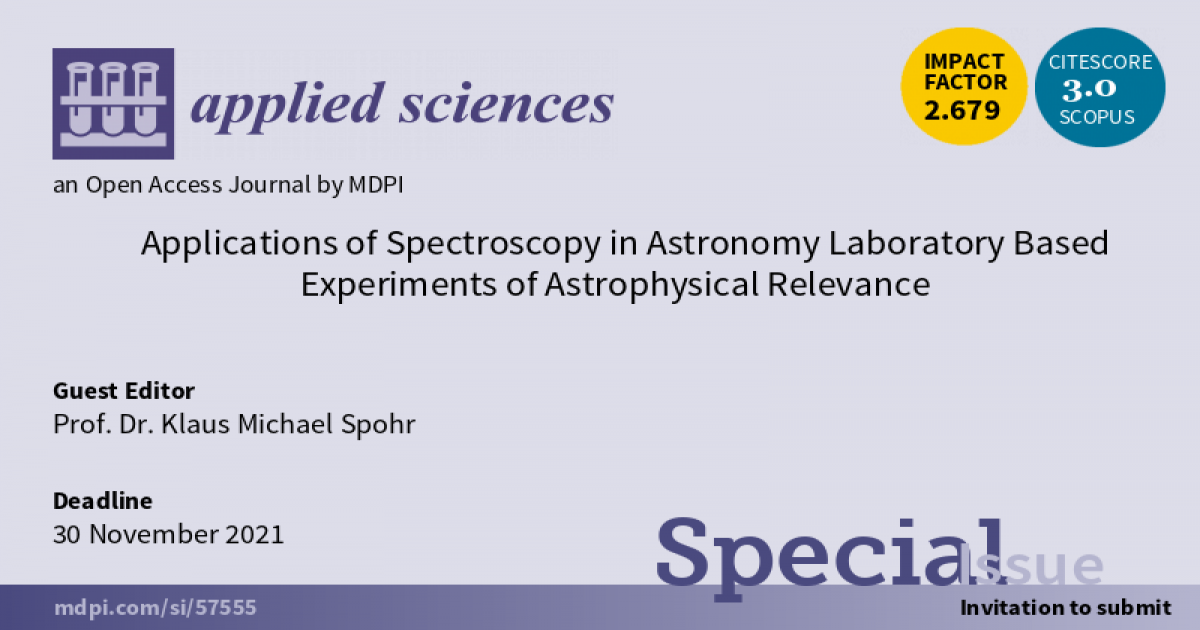- 2.5Impact Factor
- 5.5CiteScore
- 20 daysTime to First Decision
Applications of Spectroscopy in Astronomy Laboratory Based Experiments of Astrophysical Relevance
This special issue belongs to the section “Optics and Lasers“.
Special Issue Information
Dear Colleagues,
Astrophysical studies progress via a huge variety of experiments and theoretical studies in nuclear physics. New possibilities are brought to the field by the emergence of high power laser facilities in the sub-PW to PW regimes. Those all-optical accelerator systems allow the production of intense gamma-ray bursts, as well as electron, and ion acceleration simultaneously. Thus they can provide hot plasma conditions for extremely short times in laboratory experiments. These conditions resemble, to a certain degree, astrophysical scenarios and can be exploited for earth-bound investigations. As the field is relatively new, we are dedicating this Special Issue to the collection and discourse of relevant studies. This includes advanced experimental strategies, their theoretical underpinning with large-scale simulations, and the development of detector concepts that can withstand the associated experimental conditions which are inherently interwoven with the high-intensity nature of the short laser pulses. Knowing that experimental data in the field is still sparse we are also happy to include cutting-edge project plans and technical design report (TDR)-like submissions.
Prof. Dr. Klaus Michael Spohr
Guest Editor
Manuscript Submission Information
Manuscripts should be submitted online at www.mdpi.com by registering and logging in to this website. Once you are registered, click here to go to the submission form. Manuscripts can be submitted until the deadline. All submissions that pass pre-check are peer-reviewed. Accepted papers will be published continuously in the journal (as soon as accepted) and will be listed together on the special issue website. Research articles, review articles as well as short communications are invited. For planned papers, a title and short abstract (about 250 words) can be sent to the Editorial Office for assessment.
Submitted manuscripts should not have been published previously, nor be under consideration for publication elsewhere (except conference proceedings papers). All manuscripts are thoroughly refereed through a single-blind peer-review process. A guide for authors and other relevant information for submission of manuscripts is available on the Instructions for Authors page. Applied Sciences is an international peer-reviewed open access semimonthly journal published by MDPI.
Please visit the Instructions for Authors page before submitting a manuscript. The Article Processing Charge (APC) for publication in this open access journal is 2400 CHF (Swiss Francs). Submitted papers should be well formatted and use good English. Authors may use MDPI's English editing service prior to publication or during author revisions.
Keywords
- Nuclear astrophysics
- Laser-plasma
- Laser nuclear physics
- Nuclear and Plasma Simulation

Benefits of Publishing in a Special Issue
- Ease of navigation: Grouping papers by topic helps scholars navigate broad scope journals more efficiently.
- Greater discoverability: Special Issues support the reach and impact of scientific research. Articles in Special Issues are more discoverable and cited more frequently.
- Expansion of research network: Special Issues facilitate connections among authors, fostering scientific collaborations.
- External promotion: Articles in Special Issues are often promoted through the journal's social media, increasing their visibility.
- e-Book format: Special Issues with more than 10 articles can be published as dedicated e-books, ensuring wide and rapid dissemination.

